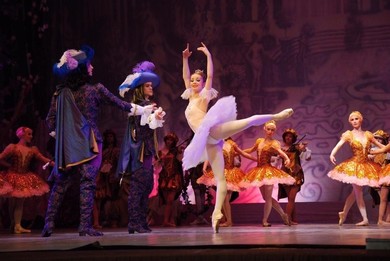Libretto: Ivan Vsevolozhsky and Marius Petipa, after tales: Charles Perrault
Set design: Heinrich Levogt, Mikhail Bocharov, Ivan Andreev, Konstantin Ivanov and Matvei Shishkov
Costumes: Ivan Vsevolozhsky
The revival team:
Choreography staged: Sergei Vikharev
Set design reproduced: Andrei Voitenko
Costumes reproduced: Elena Zaitseva
Assistant Set designers: Boris Kaminsky and Andrei Sevbo
Archive research and co-ordination: Pavel Gershenzon
World premiere: 3 January 1890, Mariinsky Theatre, St Petersburg
Premiere of the revival: 30 April 1999, Mariinsky Theatre, St Petersburg
Synopsis
Prologue
King Florestan XIV and the Queen are celebrating the birth of Princess Aurora. In the palace preparations are underway for a banquet. Master of Ceremonies Catalabutte is checking the list of guests. Guests and members of the court arrive and congratulate the king and queen. The Lilac Fairy and the Good Fairies present their gifts to the infant princess, endowing her with the finest human attributes.
Suddenly a great noise is heard: the wicked and powerful Carabosse Fairy appears. Catalabutte has forgotten to invite her to the banquet. The Master of Ceremonies is out of his mind with anxiety for his mistake may result in dire misfortune for the Princess in her future life. In a fit of anger Carabosse foretells that Aurora will die young from pricking her finger with a knitting spindle. All are overcome by despair. But the Lilac Fairy forces Carabosse to leave the palace and predicts a reprieve from death for Aurora: "In a hundred years’ time the princess, and the whole kingdom, will be awakened to happiness by a handsome prince".
Act I
It is Princess Aurora’s sixteenth birthday. Four princes have come to court her. The King and Queen urge her to make a choice. But Aurora, who is full of youth and the joys of life, refuses to listen to her parents’ entreaties. At the height of the festivities and old woman comes up to Aurora and, unnoticed, hands her a knitting spindle. Trusting Aurora takes it and continues to dance. Suddenly she stops dancing and gazes in horror at her finger which she has accidentally pricked with the spindle. Aurora is overcome by deadly cold and she dies. The old woman throws off her hood - it is Fairy Carabosse! Whirling about maliciously, she disappears in a cloud of smoke. A dreadful misfortune has overtaken the kingdom.
The Lilac Fairy appears: she has the power to mitigate evil! Aurora hasn’t died, she has fallen asleep for a hundred years. She will be woken up by the passionate kiss of a handsome prince. The Lilac Fairy puts the whole kingdom to sleep for a hundred years.
Act II
Scene 1
A century has passed. Prince Desire is hunting on his domain, but he is not particularly engrossed in the chase. He is haunted by a beautiful dream.
Suddenly the Lilac Fairy appears before the Prince. She summons a vision of Aurora surrounded by ethereal nerdish. Enchanted, the Prince hurries after the vision but, on a command from the Lilac Fairy, it disappears.
Desire implores the Lilac Fairy to search for the beautiful maiden who has captivated his heart. The Lilac Fairy and the Prince set sail in the magic boat and make for the bewitched royal castle.
Scene 2
Darkness and desolation reign in the sleeping kingdom. It is guarded by the wicked Carabosse Fairy.
The Lilac Fairy and Prince Desire approach rapidly. Fairy Carabosse and her retinue try to hide Aurora, but the Prince catches sight of her. Captivated by Aurora, he kisses her tenderly. And the evil spell is broken! Carabosse and her retinue disappear. Aurora wakes up, and with her the whole kingdom. The Princess gazes at her deliverer and love is born in her heart. Desire asks the King and Queen for Aurora’s hand.
Act III
The wedding of Aurora and Desire. The Fairy-tale Characters have come to the celebrations: Princess Florine and Blue Bird, Puss in Boots and White Cat, Red Riding Hood and the Wolf, Cinderella and the Prince.
Apotheosis
The Lilac Fairy and her retinue give their blessing for a happy life to the bride and groom.
CharactersPhotos © 2000-2006 Marc Haegeman Mariinsky Theatre:
Mariinsky Theatre:  Mariinsky-2 (New Theatre):
Mariinsky-2 (New Theatre):  Mariinsky Concert Hall:
Mariinsky Concert Hall: 

